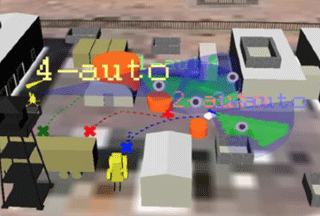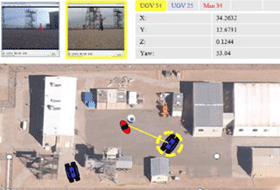
As unmanned systems (UMS) are increasingly used in the battlefield, advantages provided by strategy, tactics, and training must be translated into UMS control systems. It’s a challenge to effectively control large numbers of UMS. The human operator must focus on high-level perception, tactics, and strategy while the system automates lower-level functions. High Consequence, Automation, & Robotics (HCAR) is working to develop system controls technology for single operator, multiple UMS control.
Challenge

Unmanned systems give people distance from dangerous tasks and environments, but this limited manpower presents a challenge. Most UMS deployed today require multiple-member operating crews. The control challenge is amplified when large numbers of UMS must work together, when the environment is complex, and when there are hostile adversaries.
Need
In the future, UMS will increasingly be used for tactical operations in chaotic environments, with dynamic adversaries and rapidly changing objectives. A control system for single-operator, multiple unmanned systems control would help UMS execute tasks and respond rapidly as mission needs and priorities change.
Features
- A single operator controls a team of several (three to six) unmanned ground and aerial vehicles performing multiple solo and collaborative behaviors
- Operates effectively in tactical scenarios with dynamic, unpredictable adversaries
- The operator is in control at all times, and directs based on desired mission outcomes (e.g. get a camera on target) rather than specific actions (e.g. drive northeast 10 meters and turn to face southeast)
- Control algorithms are layered to allow variable autonomy and use of platform-specific lower-level autonomous behaviors
Applications
- Military
- Emergency response
- Law enforcement
Technology Transfer
As part of our program goals and objectives we are working closely with our industry partners to transfer this technology out of the laboratory and into a deployable system. Partnership opportunities exist for further technology and application development. For more information, please contact us.
Fact Sheets
Download the fact sheet for more information and applications (PDF, 737 KB).